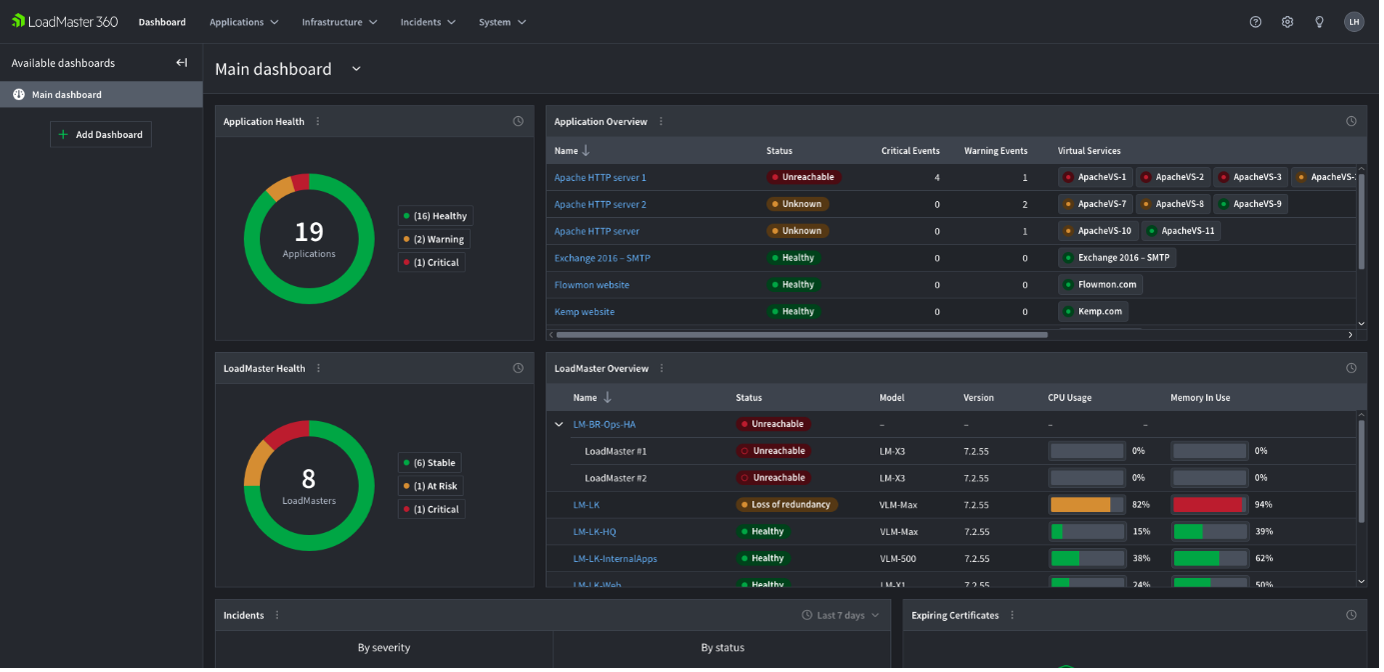Load balancing your servers and other application delivery infrastructure is essential for providing users with the best application experience. Load balancing optimizes resource usage, traffic throughput and service availability.
As application workloads shift to hybrid or pure cloud deployment models, the need for load balancing increases. Indeed, the need for a robust load-balancing solution increases as a component’s footprint, which consists of modern appliances, spreads out across cloud providers and deployment architectures such as SaaS platforms, virtual machines and microservices.
Over the last few years, the cloud-native load balancing options available from the leading cloud platforms have evolved to provide the scalability, flexibility and automation that modern applications need when running within a single cloud service. They can dynamically adapt to changing workloads and integrate more easily with container orchestration platforms like Kubernetes. This allows organizations to manage and scale their applications within each separate cloud platform.
However, in the increasingly multi-cloud deployments that many SMEs and larger businesses now operate, the need to have teams with knowledge about the load balancing options available on each separate cloud platform increases complexity and reduces productivity. Kemp LoadMaster delivers the features and functionality available via the cloud-native load balancers. It still uses the same solution across them all, simplifying deployment and management while reducing costs without sacrificing performance and security.
Cloud-Based Load Balancers: Overview
Cloud-based load balancing options from Amazon AWS, Microsoft Azure and Google Cloud provide powerful solutions for distributing traffic across multiple resources within each cloud environment. They provide the features you would expect from a load balancer, but they do so in a unique way for each platform. The AWS load balancing options work on AWS only and are different from those available on Microsoft Azure.
Cloud platform load balancers intelligently route incoming requests to the most suitable resources based on factors such as server capacity, health and proximity to the user. By evenly spreading workloads, cloud-based load balancers deliver optimal performance, scalability and high availability for applications running on each cloud platform, much like on-premises load balancers have done for decades.
One key benefit of deploying services and applications in the cloud is the ability to scale applications up and down as needs change. This dynamic elasticity allows for the handling of sudden changes in demand without having to overprovision resources. Resources that then sit idle for long periods—a poor return on investment. The load balancers in cloud platforms can dynamically add and reduce server instances and other infrastructure to deal with fluctuating demand. They can also do health monitoring to continuously check the status of resources and redirect traffic away from underperforming instances.
Cloud-based load balancers also support global load balancing across geographically separated regional cloud data centers. This protects against regional outages that take all services offline and, in normal operations, allow users to access applications and data closer to their physical location to reduce network latency.
Progress Kemp LoadMaster - Key Features
LoadMaster matches the features available for each native cloud load-balancing solution. But it does so with the same deployment and management model across all platforms. This makes building a subject matter expert team to manage infrastructure across multi-cloud, hybrid and on-premises deployments much easier.
LoadMaster provides the following features across all cloud and on-premise platforms:
- Layer 4-7 load balancing - Supports load balancing at the transport and application layers.
- TLS (SSL) offloading - Handles TLS (SSL) encryption and decryption processes to remove them from the application servers to improve server performance and reduce overhead.
- Content routing - Route traffic based on content, such as URLs, headers and cookies, enabling advanced traffic management.
- Global server load balancing (GSLB) - Distributes traffic across multiple geographically dispersed sites for improved reliability and performance.
- Server health check - Monitors the health of servers and applications, automatically redirecting traffic away from failed or underperforming servers.
- Caching and compression - Reduces server load and improves response times by caching frequently accessed data and content and by compressing data transfers.
- Security features - Includes built-in security measures like intrusion prevention, web application firewall (WAF) and DDoS protection.
- Multi-platform support – Provides flexibility across deployment scenarios either as a hardware appliance, virtual appliance or native cloud-based deployment.
- Centralized management - Uses an intuitive web interface and API for easy configuration, monitoring and administration of load-balancing services.
Read a complete LoadMaster feature list.
Performance Comparison
All the load-balancing solutions available on cloud platforms can deliver the performance a typical modern web application needs. However, comparing them is subject to many variables. Organizations would need to do a case-by-case comparison to get reliable data.
However, we can confidently state that Kemp LoadMaster is a high-performance load balancer designed to handle large volumes of traffic with low latency. It provides advanced Layer 7 load balancing capabilities, enabling intelligent traffic distribution based on application-specific criteria. Additionally, LoadMaster has a range of optimization features that help enhance application performance. When compared to native cloud load balancing options, LoadMaster offers a feature-rich and powerful load balancer at a fraction of the cost.
You should conduct thorough performance testing and benchmarking for your specific applications to make an informed performance decision between a cloud-native load balancing option and LoadMaster running in your cloud environment. This will provide your particular use case's most accurate and relevant performance metrics. You could also deploy LoadMaster at a lower cost at the start and see if it meets your performance needs, as we expect it will!
Scalability and Flexibility
Scalability and flexibility are paramount for maintaining optimal application experiences for users inside and outside an organization (or customers, as they are also known!). Organizations use load-balancing solutions to manage fluctuating user demands and traffic patterns over time. The cloud-based load balancers available in AWS, Azure and Google Cloud deliver this scalability by dynamically allocating resources based on current demand, thereby maintaining high performance and availability.
LoadMaster takes scalability and flexibility to the next level by offering a comprehensive load-balancing solution that delivers across the leading deployment cloud platforms and on-premise scenarios. Irrespective of the deployment model, LoadMaster provides the same advanced features and performance. Its ability to scale horizontally and vertically allows organizations to quickly adapt to changing requirements without compromising the application experience.
The multi-platform support and centralized management in LoadMaster also provide great flexibility for organizations with diverse infrastructure. LoadMaster enables more seamless integration with existing systems to deliver consistent load balancing. With LoadMaster, organizations can deliver optimal application experiences, regardless of the deployment scenario, while benefiting from the scalability, flexibility and cost savings that flow from deploying LoadMaster to meet the demands of modern application delivery.

Figure 1: Screenshot from the LoadMaster 360 console showing the main Dashboard view used for centralized management
Security Features
Cybersecurity must be a top-level operational priority for every organization. Due to the increasing sophistication and frequency of cyberattacks, a multi-layered approach to cyber defense is essential. Load balancers play a significant role in this layered security strategy, protecting applications and data from potential threats.
Most load balancers can be seamlessly integrated into security protection models, such as zero-trust architectures. By acting as a gateway between clients and servers, load balancers can enforce authentication, authorization and encryption policies, verifying that only trusted and verified traffic reaches application servers. This helps mitigate the risk of unauthorized access, data breaches or other security incidents.
Leading cloud providers have recognized the importance of load balancers in enhancing security. Their native load-balancing services offer built-in security features, such as SSL/TLS termination, network-level firewalls and integration with security groups and access control lists (ACLs). These features help secure traffic between clients and load balancers and between load balancers and backend servers, providing additional protection against potential threats.
LoadMaster offers enhanced security features over and above those provided by the native cloud platform load balancers. Its web application firewall (WAF) uses the industry-leading ModSecurity engine to protect against common web-based attacks, such as SQL injection, cross-site scripting and many other known attack types, including those tracked by OWASP. LoadMaster also provides intrusion prevention capabilities, detecting and blocking malicious traffic patterns in real time and including DDoS detection and prevention.

Figure 2: The WAF Insights view in the LoadMaster 360 console. It shows various insights into the application traffic being monitored by the LoadMaster load balancer.
LoadMaster includes functionality for Reverse Proxy, endpoint authentication, Active Directory and RADIUS integration, Single Sign-On (SSO) across virtual services, RSA SecurID dual-factor authentication and persistent logging and reporting. Many organizations have adopted LoadMaster to provide a supported replacement for the discontinued (and much lamented) Microsoft Threat Management Gateway (TMG).
Additionally, LoadMaster supports advanced encryption technologies, such as elliptic curve cryptography (ECC), ensuring the highest levels of data protection. Its centralized management console allows for easy configuration and monitoring of security policies across all deployment scenarios, simplifying the implementation and maintenance of a robust security posture.
Cost Considerations
Using LoadMaster as a replacement for the native load-balancing solutions provided by each cloud platform will give you a centralized solution across all deployments from a management perspective. It will also likely be cheaper to run than the native options.
As with performance, a comparison of costs will involve many variables. It will only make sense if we compare like-for-like cloud load balancing options and LoadMaster deployed in the cloud. For example, the basic Azure Load Balancer is a Layer 4 network load balancer and not a Layer 7 application load balancer like LoadMaster. So, comparing these two isn’t sensible. The Azure Application Gateway is a Layer 7 load balancer like LoadMaster, so comparing their costs is appropriate. When we do that for both with WAF functionality included, the final figures we arrive at for a deployment that supports 10TB of throughput are:
- Azure: $323.39 per month + Data costs outside Azure network
- LoadMaster: $146 per month + Data costs outside Azure network
Similar figures emerge when comparing AWS load balancers to LoadMaster. On AWS, the Application Load Balancer is the equivalent solution to LoadMaster. Application Load Balancer uses a complex pricing metric known as Load Balancer Capacity Unit (LCU) to track and charge for load balancer use. LCU tracking uses metrics such as active connections and the number of connections per second. Planning and calculating AWS Application Load Balancer costs quickly gets very complex. When you work through various scenarios, its costs are largely equivalent to those of LoadMaster. However, with LoadMaster, the pricing structure is more straightforward than the opaque calculations needed for AWS. Meaning that it’s much easier to plan for future costs with LoadMaster and not be hit with a surprise bill if traffic spikes.
The Kemp sales and consultancy team can help you compare LoadMaster costs with any cloud-native load-balancing options you might be considering.
Use Cases and Scenarios
The use cases for cloud load balancers will typically resemble those we know from on-premises deployments. Examples include:
Web applications - For basic web applications with moderate traffic and minimal security requirements, native cloud load balancers can distribute incoming requests across multiple server instances.
Cloud-native architectures - When an organization fully embraces a cloud-native approach and utilizes the native services and APIs of a specific cloud provider, using the built-in load balancers can offer tighter integration with other native cloud platform services.
Serverless applications - Native cloud load balancers are well-suited for serverless architectures, where the cloud provider manages the underlying infrastructure and the load balancer can automatically scale to handle traffic.
While native cloud load balancers are fine for simple use cases, LoadMaster excels in scenarios that demand more advanced capabilities, security and flexibility. By leveraging LoadMaster, organizations can achieve optimal application performance, scalability and security across hybrid and multi-cloud environments.
Many organizations will have infrastructure deployments that don’t map to a single cloud platform. Multi-cloud use is driven by the needs of specific applications they have purchased or the need to spread applications for contingency reasons, which means that, for many, using LoadMaster will be a better option in the long run. Here are some examples where using LoadMaster would be a better strategy:
Hybrid and multi-cloud environments – LoadMaster is capable of working seamlessly across different environments is a considerable benefit when an organization has a hybrid infrastructure or uses multiple cloud providers. LoadMaster provides a consistent load-balancing solution to deliver unified management and policies across diverse environments and platforms, with system admins only having to learn one load-balancing solution and not several.
Advanced traffic management - Compared to native cloud load balancers, LoadMaster provides more refined control over traffic routing and management. It supports advanced features to enable more sophisticated traffic handling based on specific application requirements.
Enhanced security features - Some native cloud load balancer options offer only basic security features, but LoadMaster provides a more extensive security suite. This includes an advanced web application firewall, an intrusion prevention system and advanced authentication and encryption options. With these options, LoadMaster delivers additional protection against various attacks and vulnerabilities.
Compliance and data sovereignty – LoadMaster provides visibility into the traffic and application activity occurring within your infrastructure collects data that can feed into tracking and planning needed to deliver on various regulatory frameworks. While not a dedicated compliance solution, the data that LoadMaster collects and logs is available to help deliver broader compliance strategies. This data gathering is available in on-premises, cloud and hybrid deployments.
Cost optimization - Deploying LoadMaster can be more economical than depending on native cloud load balancers in many scenarios. With a flexible licensing model and LoadMaster can operate on multiple environments can provide better cost-efficiency, particularly for organizations with high traffic volumes or requiring advanced features.
User Testimonials and Case Studies
Many organizations have deployed LoadMaster as a replacement for cloud-native load balancers. For example, Education First (EF), a global leader in international education, faced performance challenges as their student base grew, particularly in the Asia-Pacific region. To address increased latency and improve service delivery, EF decided to migrate its core applications from a US-based data center to Amazon Web Services (AWS) cloud.
During the migration, EF realized their existing F5 load balancers were unsuitable for cloud deployment. After evaluating several vendors, they chose Progress Kemp LoadMaster Virtual LoadMaster (VLM) for its AWS cloud optimization, comprehensive features, responsive support and cost-effectiveness.
EF deployed two VLM-2000 and six VLM-200 appliances, which provided L7 traffic distribution, session persistence, health checking, SSL acceleration, IPS and data caching/compression. This implementation resulted in significant performance improvements, significantly reducing average latency and enhancing the user experience for thousands of simultaneous connections.
The migration to AWS and implementation of Kemp LoadMaster allowed EF to streamline IT operations, reducing their IT staff from 30 to just four managing the entire infrastructure. This shift enabled EF to use the freed-up people to focus on developing new applications and services for students.
Post-migration, EF has a scalable IT infrastructure that supports its continued global growth. The Infrastructure Team at EF praised reliability, industry-leading support and value proposition of LoadMaster. They stated that they don't hesitate to recommend LoadMaster to others seeking load-balancing solutions. The full case study goes into more detail on the problem, the migration and how LoadMaster was the perfect choice.
You can read many more case studies and LoadMaster success stories on the Resource Library page.
Unique Advantages of Progress Kemp LoadMaster
LoadMaster is a reliable and robust load-balancing solution that offers several benefits over native cloud platform alternatives. It can perform load balancing consistently across diverse environments and provides advanced application delivery features and security capabilities, making it an excellent choice for organizations running complex infrastructure environments.
One significant advantage of LoadMaster is its flexibility and multi-platform support. Unlike load balancers designed for specific cloud platforms, LoadMaster can be deployed on-premises, in the cloud or hybrid environments. This makes it easier for organizations to maintain a consistent load-balancing strategy across their entire infrastructure, reducing complexity and simplifying management.
LoadMaster stands out from cloud-based alternatives in situations that require advanced traffic management and security features. Its content-based routing, URL rewriting and traffic scripting capabilities enable precise control over traffic distribution, providing optimal application performance. Additionally, LoadMaster can provide a robust security posture, helping safeguard applications from threats with a built-in web application firewall, intrusion prevention system (IPS) and advanced encryption options.
It does this at a lower cost in most scenarios than the equivalent cloud-native platform load balancing option.
Conclusion
LoadMaster offers the following key advantages over most cloud-native, load-balancing options. It delivers:
- Flexibility and multi-platform support for seamless integration across diverse environments.
- Advanced traffic management features for granular control and optimal application performance.
- Comprehensive security capabilities, including WAF, IPS and advanced encryption options.
- Centralized management and visibility for simplified administration and monitoring.
- Cost-effectiveness, particularly for organizations with significant traffic volumes or advanced feature requirements.
Here are some use cases that would benefit from deploying LoadMaster in preference to a native cloud load balancing option:
LoadMaster provides a consistent and flexible load-balancing solution for organizations with hybrid or multi-cloud infrastructure looking for optimal application delivery across diverse environments.
When advanced traffic management and security features are critical, such as in industries with strict compliance requirements or high-risk applications, LoadMaster features and robust security capabilities make it an ideal choice.
For organizations seeking cost optimization without compromising functionality, the licensing model of LoadMaster and its ability to work across multiple platforms can provide better value for money than relying solely on cloud-native load balancers.
LoadMaster offers a compelling alternative to cloud-based load balancers. Its unique flexibility, advanced features and security make it an ideal solution for optimal application performance, scalability and adjunct security protection in today’s IT landscape.

